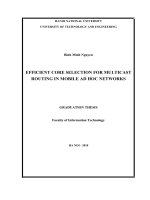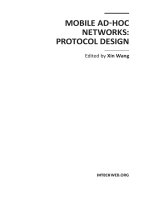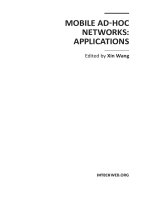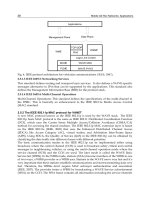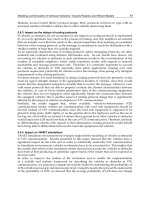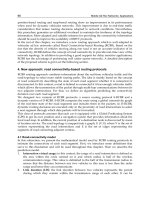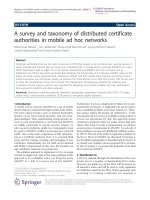A robust routing protocol for wireless mobile ad hoc networks
Bạn đang xem bản rút gọn của tài liệu. Xem và tải ngay bản đầy đủ của tài liệu tại đây (634.77 KB, 131 trang )
A ROBUST ROUTING PROTOCOL
FOR WIRELESS MOBILE AD HOC NETWORKS
WANG QIANG
NATIONAL UNIVERSITY OF SINGAPORE
2002
A ROBUST ROUTING PROTOCOL
FOR WIRELESS MOBILE AD HOC NETWORKS
WANG QIANG
(B.Eng (Hons.), NUS)
A THESIS SUBMITTED
FOR THE DEGREE OF MASTER OF ENGINEERING
DEPARTMENT OF ELECTRICAL & COMPUTER ENGINEERING
NATIONAL UNIVERSITY OF SINGAPORE
A Robust Routing Protocol for MANET Abstract
i
ABSTRACT
In Mobile Ad Hoc Networks (MANETs), routing protocols are challenged with
establishing and maintaining multi-hop routes in the presence of mobility, bandwidth
limitation and power constraints. In this thesis, we first study the various routing
strategies for MANETs. On-demand and table-driven schemes are analysed and
compared with each other. Our study shows that on-demand protocols in general
achieve better and more stable performance especially at high mobility due to their
efficient utilization of control overhead.
We next introduce a new scheme AODV-RR (Ad Hoc On-demand Distance
Vector Protocol with Redundant Routes) with improved robustness by incorporating
route redundancy into AODV. The presence of redundant routes allows provision of
immediate alternative routes to salvage time-critical traffic flows upon link failures,
hence increasing throughput and minimizing delay. Our evaluation proves that route
redundancy indeed helps boost overall routing robustness as well as efficiency.
Lastly we experiment further improving performance by making Route Expiry
Timeout (RET) adaptive to mobility. Adaptive RET proactively prevents aging of
routes especially at higher mobility and hence helps reduce the chances of using
potentially stale routes. Our investigation suggests that by selecting optimal RET
values depending on mobility, substantial performance gain can be achieved at
affordable increase in control overhead.
A Robust Routing Protocol for MANET Acknowledgement
ii
ACKNOWLEDGEMENT
The project work described in this thesis was carried out between July 2000
and July 2002 as a partial fulfilment of the requirements for the degree of Master of
Engineering at the National University of Singapore.
I would like to express my sincere gratitude and appreciation to Professor
Lawrence Wong Wai Choong for his valuable advice, guidance and supervision that
helped make this project into reality. His many comments and ideas have always been
the source of innovation and inspiration along the progress of this project.
I would also like to thank Mr. Raghuraman Ramiah from the Mobile
Multimedia Research Laboratory and Mr. Henry Tan from the Communications
Laboratory for their helpful facility arrangement and technical assistance during the
course the project. My gratitude also goes out to the secretary Ms. Dorothy Goh for
her administrative support.
A Robust Routing Protocol for MANET Contents
iii
CONTENTS
ABSTRACT
i
ACKNOWLEDGEMENT
ii
LIST OF TABLES
vi
LIST OF FIGURES
vii
LIST OF ABBREVIATIONS
x
CHAPTER ONE: INTRODUCTION
1
1.1 Background 1
1.1.1 Mobile Ad Hoc Networks (MANETs) 2
1.1.2 Routing in Mobile Ad Hoc Networks 3
1.1.3 Routing Metrics and Multimedia Traffic Requirement 4
1.2 Objectives 5
1.3 Achievements 5
1.4 Related Works 7
1.5 Organization of Thesis 8
CHAPTER TWO: REVIEW OF EARLY ROUTING PROTOCOLS
9
2.1 Introduction 9
2.2 Overview of Early Protocols 11
2.2.1 Destination-Sequenced Distance Vector Routing (DSDV) 11
2.2.2 Dynamic Source Routing (DSR) 13
2.2.3 Ad Hoc On-Demand Distance Vector Routing (AODV) 14
2.2.4 Temporally-Ordered Routing Algorithm (TORA) 16
2.2.5 Summary of Protocols 18
2.3 Simulation Setup 19
2.3.1 Environment 19
2.3.2 Methodology 20
A Robust Routing Protocol for MANET Contents
iv
2.3.3 Routing Protocol Decisions 21
2.3.4 Summary 22
2.4 Simulation Results 22
2.4.1 Packet Delivery Ratio 23
2.4.2 Control Overhead 26
2.4.3 Average End-to-end Delay 30
2.4.4 Average Delay Jitter 35
2.4.5 Remarks and Limitations 38
2.4.6 Accuracy of Simulation Estimates 39
2.5 Conclusion 40
CHAPTER THREE: EXPLOITING ROUTE REDUNDANCY
41
3.1 Background and Motivation 41
3.2 AODV in Details 43
3.2.1 Routing Table and Control Packets 44
3.2.2 An Overview By Illustration 46
3.2.3 Upon Receipt of RREQ 49
3.2.4 Upon Receipt of RREP 50
3.2.5 Upon Receipt of RERR 51
3.2.6 Route Resolution 53
3.2.7 Route Breakage Control 53
3.3 Route Redundancy Strategies 55
3.3.1 Exploiting RREQ Broadcast 55
3.3.2 Exploiting RREP Broadcast 57
3.4 AODV with Redundant Routes (AODV-RR) 59
3.4.1 Routing Table and Control Packets 59
3.4.2 An Overview By Illustration 64
3.4.3 Upon Receipt of RREQ 69
3.4.4 Upon Receipt of RREP 71
3.4.5 Upon Receipt of RERR 74
3.4.6 Route Resolution 75
3.4.7 Route Breakage Control 76
A Robust Routing Protocol for MANET Contents
v
3.5 Simulation Results 77
3.5.1 Packet Delivery Ratio 78
3.5.2 Control Overhead 80
3.5.3 End-to-End Delay 84
3.5.4 Delay Jitter 86
3.5.5 Route Optimality 89
3.5.6 Storage and Computational Complexity 90
3.5.7 Summary 94
3.6 Conclusion 94
CHAPTER FOUR: ADAPTIVE ROUTE TIMEOUT
95
4.1 Background and Motivation 95
4.2 Effect of Adaptive RET 97
4.2.1 Performance Results 98
4.2.2 Statistical Results 102
4.2.3 Conclusion 105
4.3 Finding Optimal RET 105
4.4 Adaptive RET Performance 108
4.5 Conclusion 112
CHAPTER FIVE: CONCLUSION
113
5.1 Contributions 113
5.2 Future Work 114
REFERENCES
115
A Robust Routing Protocol for MANET List of Tables
vi
LIST OF TABLES
Table 2.1 Classifications of MANET Routing Protocols 10
Table 2.2 Summary of DSDV, DSR, AODV and TORA 18
Table 2.3 Summary of Simulation Settings (Part I) 22
Table 3.1 AODV Routing Table Entry Fields 44
Table 3.2 AODV Control Packets 45
Table 3.3 AODV-RR Routing Table Entry Fields 61
Table 3.4 AODV-RR Control Packets 63
Table 3.5 Summary of Simulation Settings (Part II) 78
Table 4.1 Summary of Simulation Settings (Part III) 97
Table 4.2 Maximum Mobile Speed and Suitable RET 109
A Robust Routing Protocol for MANET List of Figures
vii
LIST OF FIGURES
Figure 2.1 DSDV-SQ Packet Delivery Ratio Performance 23
Figure 2.2 DSR Packet Delivery Ratio Performance 23
Figure 2.3 AODV-LL Packet Delivery Ratio Performance 24
Figure 2.4 TORA Packet Delivery Ratio Performance 24
Figure 2.5 Comparison of PDR Performance (20 connections) 26
Figure 2.6 DSDV-SQ Routing Overhead Performance 27
Figure 2.7 DSR Routing Overhead Performance 28
Figure 2.8 AODV-LL Routing Overhead Performance 28
Figure 2.9 TORA Routing Overhead Performance 29
Figure 2.10 Comparison of Routing Overhead Performance 30
Figure 2.11 DSDV-SQ Average End-to-end Delay Performance 31
Figure 2.12 DSR Average End-to-end Delay Performance 32
Figure 2.13 AODV-LL Average End-to-end Delay Performance 32
Figure 2.14 TORA Average End-to-end Delay Performance 33
Figure 2.15 Comparison of End-to-end Delay Performance 34
Figure 2.16 DSDV-SQ Average Delay Jitter Performance 35
Figure 2.17 DSR Average Delay Jitter Performance 36
Figure 2.18 AODV-LL Average Delay Jitter Performance 36
Figure 2.19 TORA Average Delay Jitter Performance 37
Figure 2.20 Comparison of Average Delay Jitter Performance 38
Figure 3.1 Illustration of AODV Route Discovery 47
Figure 3.2 Illustration of AODV Route Maintenance 48
Figure 3.3 AODV RREQ Handling Routine 49
Figure 3.4 AODV RREP Handling Routine 51
Figure 3.5 AODV RERR Handling Routine 52
Figure 3.6 AODV Route Resolution For Data Packets 53
Figure 3.7 AODV Route Breakage Control 54
Figure 3.8 Multiple Reverse Routes From RREQ Broadcast 55
A Robust Routing Protocol for MANET List of Figures
viii
Figure 3.9 Loop in Reverse Route from RREQ Broadcast 56
Figure 3.10 Multiple Forward Routes from RREP Broadcast 57
Figure 3.11 AODV Routing Table Structure 59
Figure 3.12 AODV-RR Routing Table Structure 60
Figure 3.13 Illustration of AODV-RR Route Discovery 64
Figure 3.14(a) Illustration of AODV-RR Route Maintenance 67
Figure 3.14(b) Illustration of AODV-RR Route Maintenance 67
Figure 3.14(c) Illustration of AODV-RR Route Maintenance 68
Figure 3.15 AODV-RR RREQ Handling Routine 70
Figure 3.16 AODV-RR RREP Handling Routine 72
Figure 3.17 AODV-RR RERR Handling Routine 75
Figure 3.18 AODV-RR Route Resolution For Data Packets 76
Figure 3.19 AODV-RR Route Breakage Control 77
Figure 3.20 PDR Performance of AODV-RR and AODV 79
Figure 3.21 PDR Performance of AODV-RR and AODV 79
Figure 3.22 Overhead Performance of AODV-RR and AODV 81
Figure 3.23 Overhead Performance of AODV-RR and AODV 81
Figure 3.24 Routing Overhead Composition of AODV 82
Figure 3.25 Routing Overhead Composition of AODV-RR 82
Figure 3.26 Routing Overhead Composition of AODV 83
Figure 3.27 Routing Overhead Composition of AODV-RR 83
Figure 3.28 Delay Performance of AODV and AODV-RR 85
Figure 3.29 Delay Performance of AODV and AODV-RR 85
Figure 3.30 Delay Jitter Performance Comparison 87
Figure 3.31 Delay Jitter Performance Comparison 87
Figure 3.32 Route Optimality of AODV and AODV-RR 89
Figure 3.33 Route Optimality of AODV and AODV-RR 90
Figure 3.34 Single RREP Return Path in AODV 92
Figure 3.35 Multiple RREP Return Paths in AODV-RR 93
Figure 4.1 PDR Performance with Different RETs 98
Figure 4.2 Overhead Performance with Different RETs 98
Figure 4.3 PDR Performance with Different RETs 99
A Robust Routing Protocol for MANET List of Figures
ix
Figure 4.4 Overhead Performance with Different RETs 99
Figure 4.5 Delay Performance with Different RETs 100
Figure 4.6 Delay Performance with Different RETs 100
Figure 4.7 Average Number of Link Breaks per Unit Call Time 102
Figure 4.8 Fraction of Routes Found from Table (First Attempt) 103
Figure 4.9 Fraction of Routes Found from Subsequent Attempts 104
Figure 4.10 PDR Performance with Various RETs 106
Figure 4.11 Overhead Performance with Various RETs 106
Figure 4.12 Delay Performance with Various RETs 107
Figure 4.13 PDR Performance of Adaptive RET 109
Figure 4.14 Overhead Performance of Adaptive RET 110
Figure 4.15 Delay Performance of Adaptive RET 110
A Robust Routing Protocol MANET List of Abbreviations
x
LIST OF ABBREVIATIONS
ABR Associativity-Based Routing
AODV Ad Hoc On-Demand Distance Vector Routing
AODV-BR AODV with Backup Routing
AODV-LL AODV with Link Layer detection of link failures
AODV-RR AODV with Redundant Routes
ARP Address Resolution Protocol
ATM Asynchronous Transfer Mode
CBR Constant Bit Rate
CBRP Cluster-Based Routing Protocol
CEDAR Core-Extraction Distributed Ad Hoc Routing
CGSR Cluster Gateway Switch Routing
CMU Carnegie Mellon University
DARPA Defence Advanced Research Projects Agency
DCF Distributed Coordination Function
DSDV Destination-Sequenced Distance-Vector Routing
DSDV-SQ DSDV with Sequence Number for update trigger
DSR Dynamic Source Routing
DSSS Direct-Sequence Spread Spectrum
FSR Fisheye State Routing
IMEP Internet MANET Encapsulation Protocol
MAC Medium Access Control
MANET Mobile Ad Hoc Networks
ns-2 Network Simulator - 2
OLSR Optimised Link State Routing
PDR Packet Deliver Ratio
QoS Quality of Service
A Robust Routing Protocol MANET List of Abbreviations
xi
RERR Route ERRor control packet
RET Route Expiry Timeout
RREP Route REPly control packet
RREQ Route REQuest control packet
SSA Signal Stability based Adaptive Routing
TCP Transport Control Protocol
TORA Temporally Ordered Routing Algorithm
TTL Time To Live
UC University of California
WRP Wireless Routing Protocol
ZRP Zone Routing Protocol
A Robust Routing Protocol for MANET Chapter One: Introduction
1
CHAPTER ONE
INTRODUCTION
This introductory chapter first describes the project background highlighting
the definition of Mobile Ad hoc Networks (MANETs) and routing in such networks.
The project objective is declared next, followed by a brief summary on the project
achievements and related works. The organization of the thesis is outlined last.
1.1 Background
Mobile computing has gained tremendous popularity in recent years.
Advancement in technology has been able to support computing devices that are much
more capable, portable while less expensive. This makes it possible to extend access
to information and personal communications beyond the traditional wired domain.
While constrained by dynamic topology and unpredictable links, mobile networks
clearly offer much greater flexibility in user access and network configuration as
compared to fixed wired networks. This project concerns a relatively new type of
mobile networks, the Mobile Ad Hoc Networks (MANETs).
A Robust Routing Protocol for MANET Chapter One: Introduction
2
1.1.1 Mobile Ad Hoc Networks (MANETs)
A Mobile Ad hoc Network (MANET) is a collection of wireless mobile nodes
dynamically forming a temporary network without the use of any existing network
infrastructure or centralized administration [1]. In contrast to conventional cellular or
wireless ATM networks, mobile nodes in MANET communicate peer-to-peer directly
through the dynamic network without relying on any wired base-stations. Each
MANET mobile node operates not only as a host, but also as a router [1] that
dynamically discovers and maintains routes to other nodes in the network whenever
necessary. The idea of ad hoc networking is sometimes called infrastructureless
networking [2].
The major advantage of MANETs is their quick deployment. Requiring no
fixed infrastructure, MANETs are considerably easy and inexpensive to setup and
configure. This makes MANETs particularly suitable for applications in temporary,
private or emergency situations. Examples of such applications include home network,
indoor e-conferencing, automotive interaction, personnel coordination during natural
disasters recovery, military maneuvers in enemy territory, and so on.
The main concern about MANETs remains on their reliability and robustness in
performance. When mobile nodes move arbitrarily, the network topology changes
frequently and unpredictably [3]. Moreover there are constraints on the link bandwidth
and battery power. All these factors bring challenges to the design of MANET
operating protocols. Lower levels in the protocol stack such as the physical layer,
multiple access control (MAC) and routing layers deserve exclusive attentions to cater
for the unique characteristics of MANETs.
A Robust Routing Protocol for MANET Chapter One: Introduction
3
1.1.2 Routing in Mobile Ad Hoc Networks
The unique characteristics of MANETs dictate that their routing schemes vastly
differ from existing shortest-path algorithms designed for static networks. Firstly,
given the higher rate of topology change in MANETs, the routing scheme must react
and converge fast enough to keep routes up-to-date. On the other hand, the routing
scheme must not be over-sensitive to topology changes to avoid causing oscillating
update events hence degraded stability. In addition, limited battery power supplies in
mobile nodes require that less computation and routing overhead is desired. All these
combined call for a robust, stable and efficient routing scheme suitable for the
MANET environment.
Since the advent of Defense Advanced Research Projects Agency (DARPA)
packet radio networks in the early 1970s [4], numerous MANET routing protocols
have been developed and proposed. To name a few, these include Destination-
Sequenced Distance-Vector Routing (DSDV) [5], Cluster Gateway Switch Routing
(CGSR) [6], Wireless Routing Protocol (WRP) [7], Ad Hoc On-Demand Distance
Vector Routing (AODV) [8], Dynamic Source Routing (DSR) [9], Temporally
Ordered Routing Algorithm (TORA) [10], Associativity-Based Routing (ABR) [11],
Signal Stability based Adaptive Routing (SSA) [12], Fisheye State Routing (FSR) [13],
Core-Extraction Distributed Ad Hoc Routing (CEDAR) [14], Zone Routing protocol
(ZRP) [15], and so on. These protocols adopted different approaches to deal with the
typical limitations of MANETs and exhibit quite distinct behaviors.
In general, these routing protocols can be classified into two categories: Table-
driven (Proactive) or Source-initiated (Reactive, Demand-driven) [16]. Table-driven
routing protocols attempt to maintain consistent, up-to-date routing information from
each node to every other node in the network. Each node is required to maintain
A Robust Routing Protocol for MANET Chapter One: Introduction
4
routing information in local tables and respond to topology changes by propagating
updates throughout the network in order to keep its routing information up-to-date.
Table-driven schemes enable routes to be immediately ready or quickly established
when needed. However, such proactive schemes in general produce excessive network
overhead through regular update broadcasts and sustain potentially stale routes when
topology changes are frequent. Examples of table-driven schemes include DSDV,
CGSR, and WRP. Unlike table-driven schemes, source-initiated on-demand routing
protocols do not consistently maintain routing information, but create routes only when
desired by the source node. This approach significantly reduces the network overhead
resulted from frequent update broadcasts, but introduces additional latency during
route discovery and maintenance procedures. Examples of source-initiated schemes
include AODV, DSR, TORA, ABR and so on. In summary, the comparison between
table-driven protocols and source-initiated protocols exhibits a trade-off between
robustness and efficiency.
1.1.3 Routing Metrics and Multimedia Traffic Requirement
Performance metrics that are most commonly used in evaluating MANET
routing protocols are the Packet Delivery Ratio (PDR) and Routing Overhead. Packet
Delivery Ratio is the fraction of data packets that are successfully delivered from
source node to destination node over the total number of data packets generated by the
source node. The higher the ratio, the more robust is the protocol. Routing Overhead
is the amount of any overhead packets transmitted other than the data packets. The
less amount of overhead packet spent per data packet, the more efficient is the
protocol. These two parameters have been taken predominantly as means to indicate
the capability of MANET routing protocols so far.
A Robust Routing Protocol for MANET Chapter One: Introduction
5
As many mobile applications involve human-to-human communications, there
is strong need to support multimedia traffic such as voice and images over the wireless
network. In such scenarios, real-time support with quality of service (QoS) constraints
is critical. Specifically, low latency is in favor of multimedia traffic. Hence when
assessing the real-time capability of MANET routing protocols, latency behavior such
as the average end-to-end delay becomes an important metric to consider.
1.2 Objectives
This project aims to explore possible approaches to improve the robustness of
exiting MANET routing protocols. A primary study is first conducted on early
MANET routing protocols to evaluate their performance and review their relative
strengths and weaknesses. Mechanisms to improve the robustness of such protocols
are investigated next. Specifically, ideas of route redundancy and adaptive route
expiry timeout are experimented and their performance evaluated. While these
enhancements can apply to other protocols, in general, we select AODV as the
benchmark.
1.3 Achievements
The following briefly summarizes the project achievements.
• Review and comparison of some early MANET routing protocols;
• Exploiting route redundancy to improve routing robustness; and
• Exploiting adaptive route expiry timeout to mobility to improve robustness.
A Robust Routing Protocol for MANET Chapter One: Introduction
6
A review study is first conducted on some early MANET routing protocols
including DSDV, DSR, AODV and TORA. Their performance are evaluated and
compared through simulations using Network Simulator-2 (ns-2) [17] following
similar environment set-up as in [1]. The results obtained are consistent with those
given in [1], which provides insight into how these protocols behave differently.
AODV is selected as the basis for later enhancement.
The idea of route redundancy is then explored. A complete and systematic
algorithm is designed to establish and maintain a mesh of redundant routes
dynamically. With the above enhancement, a new scheme AODV with Redundant
Routes (AODV-RR) is developed and its performance evaluated. As is evident from
the results that AODV-RR achieves higher PDR, smaller end-to-end delay while using
less routing overhead as compared to the original AODV, it is proven that the
redundant route mechanism is capable of improving overall robustness of MANET
routing protocols.
The project also studies the impact of making Route Expiry Timeout (RET)
adaptive to mobility on routing performance. Instead of a fixed value of RET for all
mobility cases, we experiment with smaller values of RET for higher mobility so as to
improve the freshness of route information kept in the cache. Through simulations
using ns-2, it is observed that adaptive RET mechanism further improves performance
in PDR at the expense of larger routing overhead.
A Robust Routing Protocol for MANET Chapter One: Introduction
7
1.4 Related Works
Since the advent of DARPA packet radio networks in the early 1970s [4],
numerous MANET routing protocols have been developed and proposed by ongoing
research activities around the world. Some of these works are presented in [5-15].
Specifically, table-driven schemes [5-7] maintain constant network view by proactive
and regular exchange of routing tables among all nodes. Demand-driven schemes [8-
12] initiate route discoveries only when required by traffic demand at source nodes.
There are also hybrid schemes such as ZRP [15] that applies proactive and reactive
approaches to nodes in different areas (within and outside the zone).
Classic reviews on early MANET routing protocols include [1, 16, 3]. Royer
[16] gave comprehensive introductions on the theoretical background and working
mechanism behind a few MANET protocols, classifying them into either table-driven
or source-initiated. Broch, et al [1] evaluated the performance of four early routing
protocols through simulations and laid out the results in details for comparison. Lee, et
al [3] focused on the behaviours of multicast protocols.
The idea of redundant routes aims to improve robustness by providing backup
routes when the primary route fails. The work by Lee and Gerla [18] was one of the
first to explore this idea. It proposed to rely on last-minute effort to broadcast data
packets to neighbours when encountering a link failure. In contrast, our design uses a
systematic algorithm to establish a mesh of redundant routes and support switching of
data flows at the times of link failures.
A Robust Routing Protocol for MANET Chapter One: Introduction
8
1.5 Organization of Thesis
The rest of the thesis is organized as follows. Chapter 2 reviews four early
MANET routing protocols: DSDV, DSR, AODV and TORA closely comparing their
behaviours and performance through simulations using ns-2. This initial part of the
project aims to provide insight into the distinct characteristics of the few protocols as
well as to ensure proper software settings to prepare for simulations later.
Chapter 3 presents a systematic design that exploits redundant routes
mechanism to improve the overall robustness of MANET routing protocols. The
chapter explains in details the AODV-RR implementation based on AODV and
compares their performance.
Chapter 4 deals with an investigation into the impact of adaptive route expiry
timeout (RET) with respect to mobility. We experiment with different values of RET
for each mobility case until the optimal is reached, based on which a hypothetic
formula relating RET to mobility is then proposed. The performance of a system with
such adaptive RET formula is evaluated.
Lastly as a concluding note, Chapter 5 summarizes the project’s achievements
and findings. The chapter ends with some suggestions for future work.
A Robust Routing Protocol for MANET Chapter Two: Review of Early Routing Protocols
9
CHAPTER TWO
REVIEW OF EARLY
ROUTING PROTOCOLS
This chapter reviews four early MANET routing protocols: DSDV, DSR,
AODV and TORA. The chapter first briefly discusses different classifications of
MANET routing protocols. As examples, the methodologies behind each of the above
four protocols are then described. With a bit of introduction on the software simulator
used for this project, the chapter proceeds to present the performance results of the four
protocols for comparison.
2.1 Introduction
MANET routing protocols can be classified according to many different
criteria. Firstly, depending on when route-discoveries are initiated, MANET protocols
can be either Proactive (Table-driven) or Reactive (On-demand). Next, depending on
where routing information is maintained, there are protocols with either Source
Routing or Distributed Routing strategies. In addition, where the address space is
concerned, MANET protocols can have either a Flat structure or a Hierarchical
structure. Whereas when route selection criteria are considered, MANET protocols
can be based on either Link State or Distance Vector. Each of these strategies has its
relative advantage and disadvantages. Table 2.1 gives a summary on these
classifications with some protocols named as examples.
A Robust Routing Protocol for MANET Chapter Two: Review of Early Routing Protocols
10
Table 2.1 Classifications of MANET Routing Protocols
Criteria Classification
Characteristics
Advantage/Disadvantage
Examples
Proactive
(Table-
driven)
Regular
exchange of
routing
information
Routes ready for use
immediately / Large
routing overhead
DSDV[5]
CGSR[6]
WRP[7]
When to
initiate
route
discovery
Reactive
(On-Demand)
Initiate route
request only
when needed by
traffic
Smaller routing overhead
/ Delay in route-discovery
AODV[8]
DSR[9]
Source
Routing
Routes
maintained by
source node
Complete source control /
Large storage requirement
& poor scalability
DSR[9] Where to
maintain
routing
information
Distributed
Routing
Routes
maintained by
source and
intermediate
nodes
Less burden on source &
better scalability / More
complex route
computation
AODV[8]
TORA[10]
Flat structure All nodes
function as
routers for one
another
Easy route computation &
maintenance / Poor
scalability
DSDV[5]
AODV[8]
Structure
of address
space
Hierarchical
structure
Nodes grouped
in clusters and
routing handled
by cluster heads
Good scalability /
Complex route
computation and
maintenance
CGSR[6]
CBRP[19]
Distance
Vector
Select routes
with shortest
path
Easy route computation /
Slow convergence or sub-
optimal
DSDV[5]
AODV[8]
Route
selection
criteria
Link State Select routes
with best link
quality
Optimal routes / Complex
route computation
FSR[13]
OLSR[20]
One of the classic reviews on early MANET routing protocols is given in [1].
It was the first to provide a realistic and quantitative analysis comparing the
performance of a variety of MANET routing protocols [1]. With extensive use of the
Network Simulator ns-2 [17], the paper presented detailed simulation results showing
the relative performance of four proposed protocols: DSDV, DSR, AODV and TORA.
A Robust Routing Protocol for MANET Chapter Two: Review of Early Routing Protocols
11
Due to the contributions from continuous research efforts, both the Network
Simulator ns-2 and the individual protocol implementation codes have evolved
substantially since the paper was published. This part of the project aims to re-
evaluate the performance of the above four early MANET routing protocols through
simulations using ns-2 with similar environment settings. The performance results
provide much insight into the unique protocol behaviours.
2.2 Overview of Early Protocols
As representatives of different classes (see Table 2.1), the four early routing
protocols of interest: DSDV, DSR, AODV, TORA were built on different mechanisms
and exhibit unique characteristics. Despite the many differences, all protocols dealt
with two issues: the initial route discovery and subsequent route maintenance.
2.2.1 Destination-Sequenced Distance Vector Routing (DSDV)
DSDV [5] is a distributed (hop-by-hop) table-driven distance-vector routing
protocol requiring each node to periodically broadcast routing updates. The key
advantage of DSDV over traditional distance vector protocols is that it guarantees
loop-freedom [1].
Each DSDV node maintains a routing table listing all reachable destinations
with the “next hop” address as well as the number of hops to each destination. Each
routing table entry is tagged with a sequence number originated and monotonically
increased by the destination node. The sequence numbers enable the mobile nodes to
distinguish stale routes from new ones, thereby avoiding the formation of routing loops
[16]. To maintain the consistency of route tables in a dynamically varying topology,
A Robust Routing Protocol for MANET Chapter Two: Review of Early Routing Protocols
12
routing table updates are transmitted throughout the network periodically, and
immediately when significant new information is available. When comparing two
routes to the same destination, the route with a higher sequence number is always more
favourable; or in the event that two routes have the same sequence number, the route
with shorter metric is considered more favourable. The above propagation of route
updates is triggered periodically and whenever new network conditions are detected,
regardless of network traffic demand. When such routing updates converge in time, all
nodes should keep a consistent view of the whole network and maintain a shortest
route to each reachable destination in its routing table. Hence routes are immediately
ready for use when demanded by any network traffic. Such an approach of proactive
exchange and computation of routing information is known as proactive routing.
When a node decides that its route to a destination is broken, it updates the
metric to that destination to infinity, increments the sequence number for that route by
one and advertises this new route entry to the rest of the network through a broadcast.
This will cause all upstream nodes of the broken route to incorporate the infinity-
metric into their own routing tables until they hear newer route updates with a higher
sequence number from that destination later.
The major advantage of DSDV as a proactive algorithm is that routes are
available immediately whenever needed. In addition, the exchange of routing updates
is triggered proactively regardless of traffic demand; hence the amount of routing
overhead incurred is theoretically constant for all mobility and traffic load cases.
However, the periodic network-wide broadcasts of routing table updates
usually cost excessive routing overhead, which are sometimes unnecessary especially
when mobility or traffic load is low. Such massive routing overhead not only
consumes precious wireless bandwidth and mobile node battery power, but also
